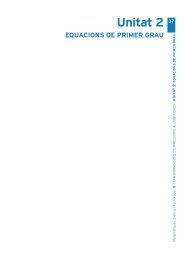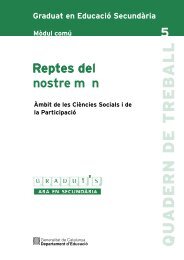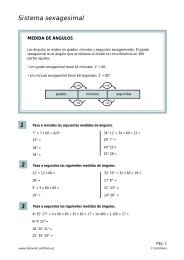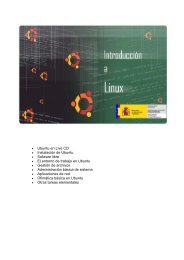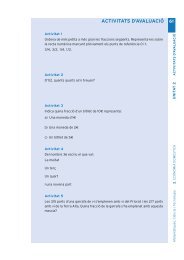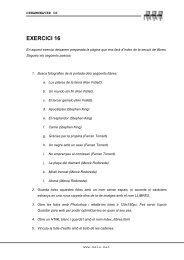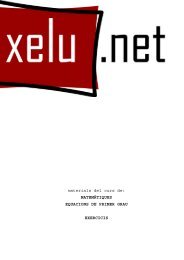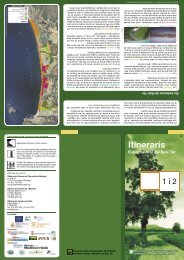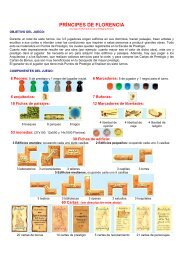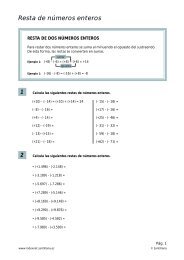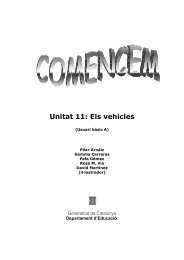COMPONENTS
COMPONENTS
COMPONENTS
Create successful ePaper yourself
Turn your PDF publications into a flip-book with our unique Google optimized e-Paper software.
BUILDING STABLES<br />
Placing a stable on a pasture doubles the capacity of the entire pasture<br />
(see example, back of rulebook). Stables can be built at a cost of 2 wood<br />
using the action space “Build house and/or stables” (Hausbauten und/oder<br />
Stallbauten). They may be placed on any space in the farmyard that does<br />
not already contain a room or a field, and may not be removed. Only 1<br />
stable may be built in any farmyard space. Stables need not be fenced in.<br />
A player may fence the stable in later, in order to double the capacity of<br />
the new pasture. Each stable that is not fenced in may hold exactly 1 animal.<br />
Animals breed at the very end of Harvest time (see page 4).<br />
OCCUPATION AND IMPROVEMENT CARDS<br />
At the start of the game, each player receives 7 Occupation cards and 7 Improvement<br />
cards.<br />
After the stable is built, there is room<br />
for 4 more animals.<br />
When the term “supply” (Vorrat) is<br />
used on a card, it always means the<br />
general supply, unless it specifically<br />
states otherwise.<br />
OCCUPATION CARDS<br />
Using the “1 Occupation” (1 Ausbildung) action spaces, a player can play<br />
one of these cards face-up on the table.<br />
On the “1 Occupation” action space that is printed on the<br />
left-hand gameboard, a player’s first Occupation is free,<br />
each additional Occupation costs 1 Food. In the 3-5 player<br />
game, a second Occupation space has varying costs<br />
depending on the number of players (see the appropriate<br />
action cards). The text on the Occupation cards applies to the<br />
player as soon s/he plays the card. Cards that are in a player’s<br />
hand have no effect on the game.The Countryman (Landwirt),<br />
Acrobat (Akrobat) and Net Fisherman (Netzer) cards are<br />
printed with a “Claim” (Anspruch) symbol – if a player with<br />
this Occupation meets the stated requirement, s/he places<br />
a Claim token on the appropriate Action space to stake a claim.<br />
IMPROVEMENT CARDS<br />
As well as the Minor Improvements,<br />
there are also 10 Major Improvement<br />
cards. In each game, different Minor Improvements will<br />
come into play but the same Major Improvements are<br />
available in each game and may be used by any player.<br />
These are described in Chapter 3 of the Appendix.<br />
The “Net Fisherman” (Netzer): when a<br />
player uses a family member to harvest<br />
reeds, the green Claim marker is placed<br />
on the “Catch Fish” (Fischfang) space.<br />
If there is still Food on the space during the<br />
“return home” phase, the player receives it.<br />
In a game with 1-3 players, place the<br />
“Major Improvement” cards on a large<br />
supply board printed across the reverse<br />
sides of two of the farmyards<br />
The action space “1 Major or Minor Improvement”<br />
(1 große oder kleine Anschaffung) allows a player to<br />
purchase either a major or minor Improvement – as does the Renovation space. Minor<br />
Improvements may also be purchased – in conjunction with otheractions – on the “starting<br />
player” (Startspieler) and “Family Growth” (Familienzuwachs) action fields. Players<br />
may not choose the action “After family growth, a Minor Improvement” (nach<br />
Familienzuwachs auch kleine Anschaffung) and only purchase an Improvement: This card<br />
only allows an Improvement after Family Growth (see Actions, B.) . The upper right corner<br />
of an Improvement card shows its cost: which goods a player must pay in order to play<br />
the card. Some Minor Improvements do not require the player to pay anything but only<br />
require that s/he “has” something – this is shown in the top left corner.<br />
required<br />
Cost<br />
Many Minor and all Major Improvements are worth Victory Points at the<br />
end of the game. These are shown by the symbol at the left under the<br />
picture. The Bonus Points symbol on some cards indicates that they also<br />
give variable bonus points – these are described in the text on the card.<br />
Some Minor Improvements are Moving cards: they are played,<br />
carried out and then placed in the hand of the next player to the left.<br />
These are indicated by the brown arrow.<br />
Victory<br />
Points<br />
Seven Minor Improvements are upgrade cards. Playing these cards does<br />
not only cost goods but also requires the player to return an existing<br />
played or acquired Improvement.<br />
Bonus Points



